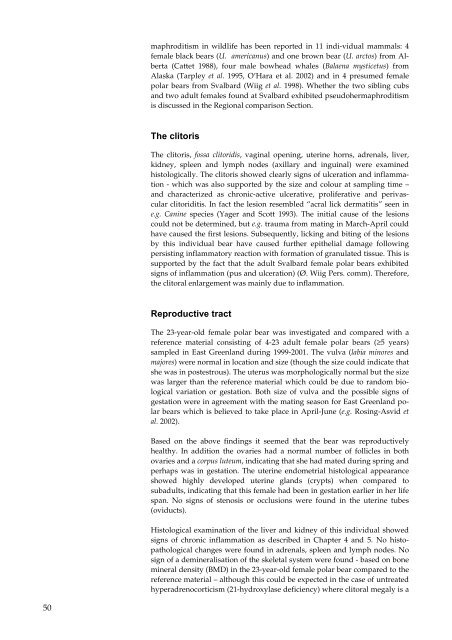Organohalogen concentrations and a gross and histologic ...
Organohalogen concentrations and a gross and histologic ...
Organohalogen concentrations and a gross and histologic ...
Create successful ePaper yourself
Turn your PDF publications into a flip-book with our unique Google optimized e-Paper software.
50<br />
maphroditism in wildlife has been reported in 11 indi-vidual mammals: 4<br />
female black bears (U. americanus) <strong>and</strong> one brown bear (U. arctos) from Alberta<br />
(Cattet 1988), four male bowhead whales (Balaena mysticetus) from<br />
Alaska (Tarpley et al. 1995, O’Hara et al. 2002) <strong>and</strong> in 4 presumed female<br />
polar bears from Svalbard (Wiig et al. 1998). Whether the two sibling cubs<br />
<strong>and</strong> two adult females found at Svalbard exhibited pseudohermaphroditism<br />
is discussed in the Regional comparison Section.<br />
The clitoris<br />
The clitoris, fossa clitoridis, vaginal opening, uterine horns, adrenals, liver,<br />
kidney, spleen <strong>and</strong> lymph nodes (axillary <strong>and</strong> inguinal) were examined<br />
<strong>histologic</strong>ally. The clitoris showed clearly signs of ulceration <strong>and</strong> inflammation<br />
- which was also supported by the size <strong>and</strong> colour at sampling time –<br />
<strong>and</strong> characterized as chronic-active ulcerative, proliferative <strong>and</strong> perivascular<br />
clitoriditis. In fact the lesion resembled “acral lick dermatitis” seen in<br />
e.g. Canine species (Yager <strong>and</strong> Scott 1993). The initial cause of the lesions<br />
could not be determined, but e.g. trauma from mating in March-April could<br />
have caused the first lesions. Subsequently, licking <strong>and</strong> biting of the lesions<br />
by this individual bear have caused further epithelial damage following<br />
persisting inflammatory reaction with formation of granulated tissue. This is<br />
supported by the fact that the adult Svalbard female polar bears exhibited<br />
signs of inflammation (pus <strong>and</strong> ulceration) (Ø. Wiig Pers. comm). Therefore,<br />
the clitoral enlargement was mainly due to inflammation.<br />
Reproductive tract<br />
The 23-year-old female polar bear was investigated <strong>and</strong> compared with a<br />
reference material consisting of 4-23 adult female polar bears (≥5 years)<br />
sampled in East Greenl<strong>and</strong> during 1999-2001. The vulva (labia minores <strong>and</strong><br />
majores) were normal in location <strong>and</strong> size (though the size could indicate that<br />
she was in postestrous). The uterus was morphologically normal but the size<br />
was larger than the reference material which could be due to r<strong>and</strong>om biological<br />
variation or gestation. Both size of vulva <strong>and</strong> the possible signs of<br />
gestation were in agreement with the mating season for East Greenl<strong>and</strong> polar<br />
bears which is believed to take place in April-June (e.g. Rosing-Asvid et<br />
al. 2002).<br />
Based on the above findings it seemed that the bear was reproductively<br />
healthy. In addition the ovaries had a normal number of follicles in both<br />
ovaries <strong>and</strong> a corpus luteum, indicating that she had mated during spring <strong>and</strong><br />
perhaps was in gestation. The uterine endometrial <strong>histologic</strong>al appearance<br />
showed highly developed uterine gl<strong>and</strong>s (crypts) when compared to<br />
subadults, indicating that this female had been in gestation earlier in her life<br />
span. No signs of stenosis or occlusions were found in the uterine tubes<br />
(oviducts).<br />
Histological examination of the liver <strong>and</strong> kidney of this individual showed<br />
signs of chronic inflammation as described in Chapter 4 <strong>and</strong> 5. No histopathological<br />
changes were found in adrenals, spleen <strong>and</strong> lymph nodes. No<br />
sign of a demineralisation of the skeletal system were found - based on bone<br />
mineral density (BMD) in the 23-year-old female polar bear compared to the<br />
reference material – although this could be expected in the case of untreated<br />
hyperadrenocorticism (21-hydroxylase deficiency) where clitoral megaly is a

















